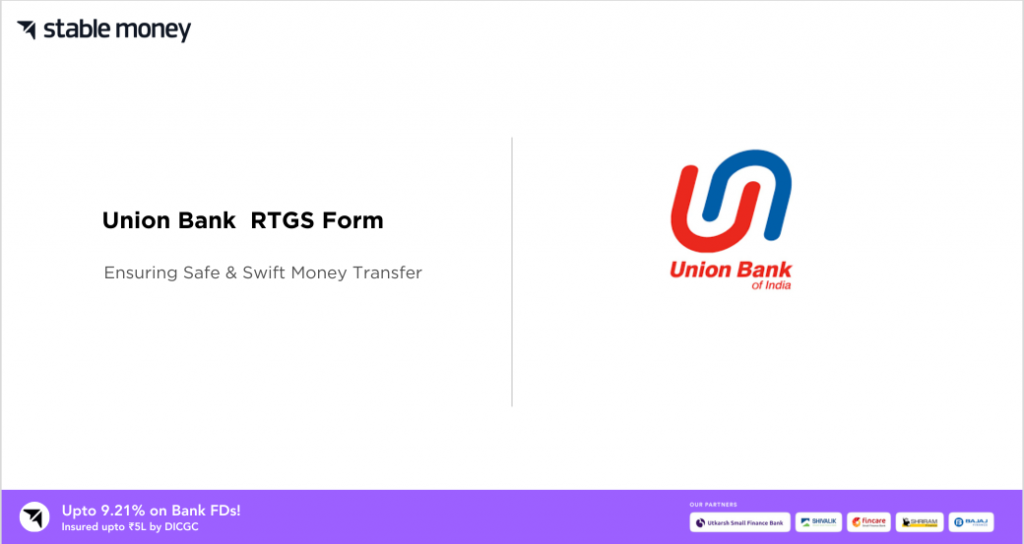
The Union Bank of India is a leading Indian public sector bank, that is headquartered in Mumbai. It allows its customers to conduct banking transactions conveniently through various banking products. The process includes the issuing of the Union Bank RTGS form or NEFT form for the transfer of funds from one bank account to the other in real time.
Below is a table showing a brief overview of the Union Bank RTGS form:
| Type of Form | RTGS/NEFT Application Form |
| Name of Bank | Union Bank of India |
| Official Website | https://www.unionbankofindia.co.in/english/rtgs.aspx |
| Uses of Form | Online Transfer of Funds |
| Minimum Limit | For RTGS – ₹2 lakhsFor NEFT – no minimum limit. |
| Maximum Limit | For RTGS – No maximum limit For NEFT – No maximum limit |
| Beneficiary | Bank Customers |
| Form Language | English, Hindi |
| Union Bank RTGS Form PDF | Union Bank RTGS Form PDF Download |
What Is Union Bank RTGS?
The RTGS or the Real Time Gross Settlement by the Union Bank of India is an electronic system to transfer funds across banking channels available in the country. You can opt for this fund transfer mechanism in one of the 50,000 of its bank branches, only if the amount is or above ₹2 lakhs.
What Is Union Bank NEFT?
The Union Bank NEFT or the National Electronic Funds Transfer is a simple, cost-effective and fastest way to transfer funds to other Union Bank accounts across the country. These fund transfers are issued at fixed times and are especially beneficial for retail remittances.
How to Download Union Bank RTGS Form?
The following is a step-by-step guide you need to follow to download the Union Bank RTGS form.
- Step 1: Visit the official website of the Union Bank of India.
- Step 2: Log in to your account with your credentials.
- Step 3: Navigate to the RTGS form option.
How to Fill the Union Bank RTGS Form?
Given below are the steps that you can follow to fill out the Union Bank RTGS form easily:
- Step 1: Visit the official website of the Union Bank of India.
- Step 2: Log in to your account with your credentials.
- Step 3: Download the RTGS form from the website.
- Step 4: Fill in the required details one by one starting with the beneficiary bank name, its branch, amount to be transferred, sender bank branch name, beneficiary bank IFSC code, cheque number, and beneficiary account type.
- Step 5: Preview and double-check all the information given in the form.
- Step 6: Sign the form in the place of the beneficiary’s signature.
You can submit the duly filled RTGS form to the nearest Union Bank of India branch.
How to Fill the Union Bank NEFT Form?
Given below is a step-by-step process on how to fill up a Union Bank NEFT form easily:
- Step 1: Visit the official website of the Union Bank of India.
- Step 2: Log in to your account with your credentials.
- Step 3: Download the NEFT form from the website.
- Step 4: Fill in the required details one by one starting from the current date, IFSC code, sender’s details, beneficiary’s details, and amount to be transferred.
- Step 5: Preview and double-check all the information given in the form.
- Step 6: Sign the form in the place of the customer’s signature.
You can submit the duly filled NEFT form to the nearest Union Bank of India branch.
Documents Required Along with Union Bank RTGS Form
Given below is a list of the documents required to submit along with the Union Bank of India RTGS form:
- Cheque leaf of the beneficiary
- Duly filled Union Bank RTGS form along with the necessary details of the beneficiary
- Additional documents as the requirements of the Union Bank of India if required
You can always consider visiting the nearest Union Bank branch to confirm the list of documents required for RTGS or resolve any queries that you may have regarding the same.
Union Bank RTGS/NEFT Timings
The following table shows the Union Bank of India RTGS timings:
| Monday to Friday (7:00 AM to 6:00 PM) | Transactions are allowed |
| Working Saturdays (Except 2nd and 4th Saturdays) from 7:00 AM to 6:00 PM | Transactions are allowed |
| Sundays and public holidays | No transactions are allowed |
Take a look at the Union Bank of India NEFT timings:
| Monday to Friday (8:00 AM to 6:30 PM) | Transactions are allowed |
| Working Saturdays (Except 2nd and 4th Saturdays) from 8:00 AM to 6:30 PM | Transactions are allowed |
| Sundays and public holidays | No transactions are allowed |
Union Bank RTGS and NEFT Charges
Here is a table showing the Union Bank of India RTGS charges:
| Amount of RTGS | Transaction Service Charges (Exclusive of GST) |
| ₹2 lakhs to ₹5 lakhs | ₹25.00 + taxes (from 8:00 AM to 11:00 AM) ₹27.00 + taxes (from 11:00 AM to 1:00 PM) ₹30.00 + taxes (after 1:00) |
| More than ₹5 lakhs | ₹50.00 + taxes (from 8:00 AM to 11:00 AM) ₹52.00 + taxes (from 11:00 AM to 1:00 PM) ₹55.00 + taxes (after 1:00) |
Below is a table showing the Union Bank of India NEFT charges:
| Amount of NEFT | Transaction Service Charges (Exclusive of GST) |
| Up to ₹10,000 | ₹2.61 + taxes |
| Over ₹10,000 and up to ₹1 Lakh | ₹5.22 + taxes |
| Over ₹1 Lakh and up to ₹2 Lakhs | ₹14.78 + taxes |
| More than ₹2 Lakhs | ₹25.22 + taxes |
What Happens if Union Bank RTGS Transaction is Not Processed on Time?
If your RTGS transaction is not processed on time, the amount will be returned to the beneficiary’s account within an hour according to the Reserve Bank of India. The original debit entry will be reversed once the amount is received back by the remitting bank.
Final Word
Filling out the Union Bank RTGS form and NEFT form is a very easy and hassle-free process. You can simply fill in the required details and submit it along with the documents. However, you must ensure to provide an error-free form for a successful RTGS or NEFT transaction processing.
Top Investment Pages
FAQs
Yes, RTGS can be processed by transferring money between two bank accounts of the same bank. It can also be processed between two different banks through Internet banking.
No, the RTGS process can not be cancelled once it has been initiated.
The primary benefit of the RTGS service is that it is the fastest and most secure way of transferring funds from one bank account to the other through a real-time fund transfer system.
Disclaimer
This article is solely for educational purposes. Stable Money doesn't take any responsibility for the information or claims made in the blog.
